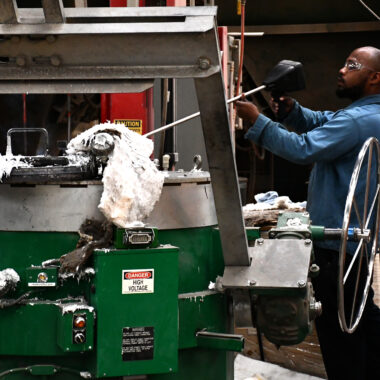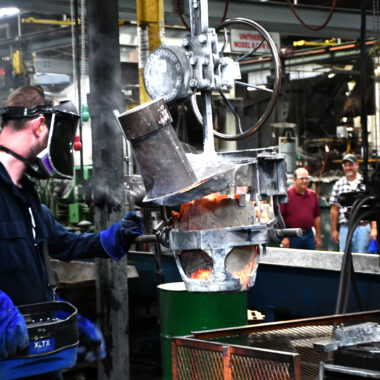Crafting Radiance: Browsing the Globe About Aluminum Casting
Wiki Article
From Style to End Up: The Full Aluminum Casting Refine Demystified
In the world of production, the procedure of aluminum casting stands as a crucial approach that has fueled sectors for years. Each action in this intricate process, from the initial style stage to the last complements, plays a vital role fit the end result of the item. What really lies underneath the surface of this process stays a secret to lots of. By untangling the intricacies and losing light on the subtleties associated with each phase, a deeper understanding of the art and science behind aluminum casting arises. about aluminum casting. Keep tuned as we study the full light weight aluminum casting process, uncovering the intricacies that transform basic materials into polished items.Creating the Casting Mold
When initiating the light weight aluminum casting process, meticulous focus to making the spreading mold and mildew is critical for guaranteeing the final item's stability and top quality. The casting mold and mildew acts as the foundation for the whole casting process, determining the shape, measurements, and surface coating of the ultimate aluminum part.To design an efficient casting mold, designers must consider various elements such as the complexity of the component, the kind of light weight aluminum alloy being used, and the preferred homes of the final product. about aluminum casting. Computer-aided layout (CAD) software application is often used to produce in-depth schematics of the mold and mildew, permitting specific customization and optimization
Additionally, the layout of the casting mold straight impacts the efficiency and cost-effectiveness of the spreading procedure. A well-designed mold and mildew decreases material waste, lowers the requirement for considerable post-casting machining, and enhances general manufacturing rate.
Melting and Putting Light Weight Aluminum
With the style of the spreading mold settled, the next critical step in the aluminum casting procedure is the melting and putting of the light weight aluminum alloy. When the light weight aluminum is liquified, it is vital to preserve the temperature level within a specific variety to guarantee the quality of the castings.After the aluminum gets to the desired consistency, it is time for putting. The liquified light weight aluminum is very carefully transferred from the heating system to the casting mold and mildew. This action calls for precision and control to avoid issues in the end product. The pouring procedure must be implemented promptly to stop premature solidification and ensure the aluminum fills the mold and mildew totally. Proper putting methods contribute considerably to the overall top quality of the final aluminum casting.
Solidifying and Cooling Down Refine
Upon completion of the pouring procedure, the liquified light weight aluminum shifts into the cooling down and strengthening phase, a critical point in the light weight aluminum spreading process that straight influences the last product's stability and characteristics. As the light weight aluminum starts to cool down, its particles prepare themselves into a solid kind, slowly tackling the shape of the mold and mildew. The price at which the light weight aluminum cools down is vital, as it affects the material's microstructure and mechanical properties. Fast air conditioning can result in a finer grain structure, boosting the product's strength, while slower cooling might result in bigger grain dimensions, affecting the end product's ductility.Throughout this stage, it is important to regulate you could try these out the cooling process carefully to avoid defects such as porosity, shrinkage, or inner anxieties. Numerous air conditioning techniques, such as air cooling, water quenching, or controlled cooling chambers, can be used based on the particular requirements of the spreading (about aluminum casting). By controling the solidification and keeping track of and cooling process, manufacturers can make certain the manufacturing of high-grade aluminum spreadings with the wanted metallurgical and mechanical residential properties

Eliminating the Final Casting
When the light weight aluminum spreading has actually adequately strengthened and cooled in the mold, the next action in the procedure includes meticulously removing the last casting. This action is crucial to make sure that the light weight aluminum component is efficiently extracted without any damage or flaws.To get rid of the spreading, the mold and mildew is opened up, and the casting is drawn out utilizing different approaches relying on the intricacy of the mold and mildew and the part design. For simpler shapes, the spreading can frequently be easily eliminated by hand or with easy tools. For more elaborate styles, additional equipment such as ejector pins, air blasts, or hydraulic systems might be called for to assist in the elimination procedure without triggering any type of harm to the casting.
After the spreading is efficiently removed from the mold and mildew, any kind of excess material such as entrances, runners, or risers that were utilized during the spreading process are trimmed off. This action aids in achieving the last preferred shape of the light weight aluminum component before it undergoes any type of additional completing processes.
Finishing and Top Quality Inspection
The final phase in the aluminum casting procedure entails precise finishing strategies and extensive quality assessment procedures to ensure the honesty and precision of the actors aluminum parts. Ending up techniques such as grinding, fining sand, and shot blasting are utilized to get rid of any type of excess material, smooth rough surface areas, and improve the visual charm of the last item. These processes not just enhance the appearance however likewise make certain that the parts fulfill the defined dimensional resistances and surface finish requirements.
Conclusion
Finally, the light weight aluminum casting procedure involves creating the mold, melting and putting light weight aluminum, cooling the spreading and strengthening, eliminating the final product, and do with a top quality assessment. Each step is vital in ensuring the end product meets the wanted requirements. By understanding the entire procedure, makers can generate top quality aluminum spreadings efficiently and efficiently.Remain tuned as we study the complete light weight aluminum casting procedure, revealing the intricacies that change raw materials into refined products.
With the design of the casting mold click now and mildew settled, the next essential step in the aluminum spreading procedure is the melting and putting of the light weight aluminum alloy.Upon completion of the pouring process, the liquified aluminum changes right into the cooling and strengthening phase, an important stage in the light weight aluminum spreading process that directly impacts the final item's stability and qualities.The last phase in the aluminum casting process involves meticulous finishing strategies and rigorous top quality examination procedures to ensure the stability and precision of the actors light weight aluminum components.In conclusion, the aluminum casting process involves creating the mold, melting and pouring aluminum, solidifying and cooling the casting, getting rid of the last item, and completing with a quality evaluation.
Report this wiki page